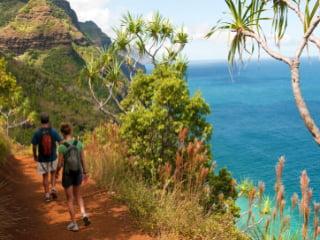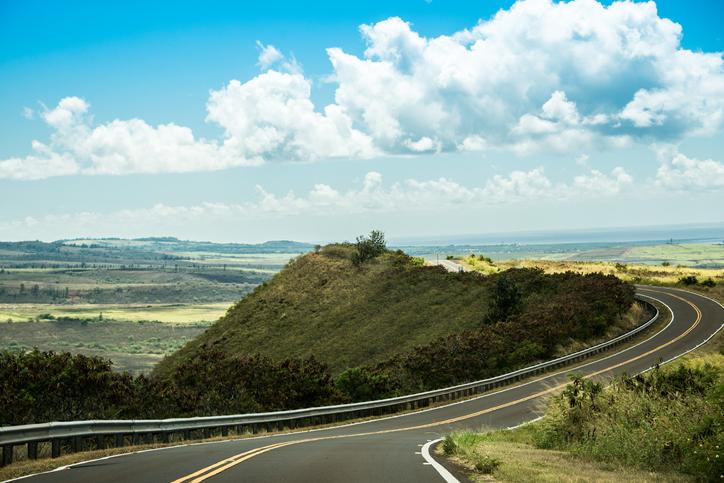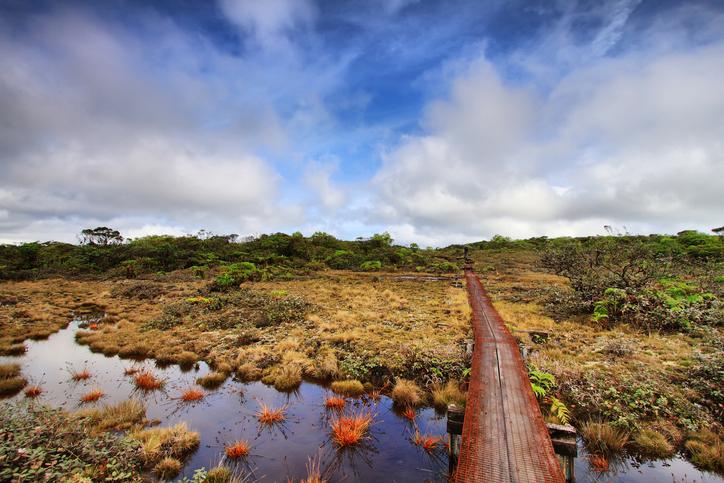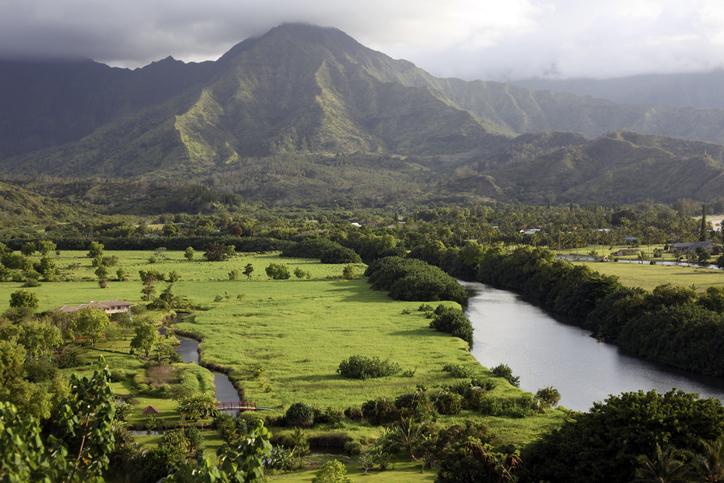Kauai is as far west as you can go to Hawaii. Well, there is one more island to Kauai’s west -- Niihau -- but you won’t be making a visit anytime soon. It’s privately owned and guarded by a modern security task force. And the people there still live an ancient Hawaiian lifestyle.
And Kauai is as far west as you can reasonably go in the United States. There are a handful of Alaskan islands that reach farther west, but they are uninhabited. So, when you watch the sunset of the west coast of Kauai, you’re watching the sunset on the American empire.
It feels remote out here on The Garden Isle. The island’s government has outlawed the construction of any building taller than a palm tree. There is no semblance of the city. It’s an island that falls asleep early to wake up at dawn with the crowing of wild roosters.
Outdoor adventures start at dawn. Kauai is the lushest and most verdant of all the islands in Hawaii. Its central dormant volcano -- Mount Waialeale -- is the rainiest place on earth, and all that rainfall converges in its crater to carve Hawaii’s only navigable rivers back to the ocean. And the rivers wind their way past waterfall-covered mountains, horse pastures, and white sand beaches.
Kauai is The Garden Isle, and it’s a fitting nickname. You’ll be able to pick wild avocado, mango, star fruit, strawberry guava, longan, rambutan, lemons, and limes as you adventure deep into the heart of the island. You can even pick the awapuhi ginger bulb, the main ingredient in Paul Mitchell shampoo, which will yield fragrant soap for a week. It’s an island that constantly provides.
And Kauai may be the smallest of Hawaii’s four main touristed islands, but it packs a natural punch. It’s absolutely drenched in outdoor wonders, and these once-in-a-lifetime sites attract nature lovers from around the world; nature lovers that yearn to roam wild, return to their hotel tired and fall asleep early only to wake at dawn to do it all over again.
The Na Pali Coast
 Kauai’s magnificent Na Pali Coast may be the most photographed natural wonder in Hawaii. The entire west coast of the island is covered in cathedral cliffs that reach out into the ocean like the talons of an island-sized dragon. Each of these cliffs is weathered, craggy and dramatic. They catch the rain to funnel the water into a series of deep, beautiful valleys each with its own personality.
Kauai’s magnificent Na Pali Coast may be the most photographed natural wonder in Hawaii. The entire west coast of the island is covered in cathedral cliffs that reach out into the ocean like the talons of an island-sized dragon. Each of these cliffs is weathered, craggy and dramatic. They catch the rain to funnel the water into a series of deep, beautiful valleys each with its own personality.
It’s difficult to explore this rugged landscape, but it’s well worth the effort for the intrepid. You can join a boat or catamaran tour that will guide you in between Kauai and Niihau in order to see the landscape from afar. Other boats may attempt a beach landing, but the ocean is often violent. But the most difficult and personal way to explore this remote coast is on foot.
The Kalalau Trail
 The Kalalau Trail is the most difficult hike in Hawaii. The 11-mile one-way trek to Kalalau Valley starts on the northern side of the Na Pali Coast at Ke’e Beach. You’ll find the trailhead in the beach’s small parking lot under the canopy of the rainforest. Parking here is difficult and tight, so it’s highly advisable to get here early in the morning. And you’ll need to get here early in the morning to have enough sunlight to traverse the trail.
The Kalalau Trail is the most difficult hike in Hawaii. The 11-mile one-way trek to Kalalau Valley starts on the northern side of the Na Pali Coast at Ke’e Beach. You’ll find the trailhead in the beach’s small parking lot under the canopy of the rainforest. Parking here is difficult and tight, so it’s highly advisable to get here early in the morning. And you’ll need to get here early in the morning to have enough sunlight to traverse the trail.
But there’s no coming back. At least not on the same day. The 11-mile trek is too difficult to complete an out-and-back trip. You’ll need to register yourself for a camping permit and stay overnight in the prized valley of the Na Pali Coast.
The trail starts on a staircase made of stones through thick rainforest. The trail then gives way to dirt as you break through the canopy. You’ll be able to look back at the stunning beauty of Ke’e Beach, tucked up against the first cathedral cliff of the Na Pali Coast, just as you break the treeline. It’s beautiful, but there’s so much more to come.
About a mile up, you’ll crest the cliff, and you’ll be able to see all the way down the indomitable coast. Each cliff rising and falling in succession for as far as the eye can see. And that’s your path; up and over, up and over for 11 miles.
The first valley is Hanakapai. This is where many on the trail will stop to turn into the valley to chase the 1,600-foot waterfall at its end. But you’ll continue up the second cliff. And you’ll continue crossing streams to follow the dirt trail until you get to Crawler’s Ledge. For a quarter-mile, you’ll hug a 16-inch wide path carved into a cliff wall. On your right, a drop to the violent ocean with no way out.
But, if you have the mettle, you’ll be rewarded with the beauty of Kalalau Valley. It’s a stunning and dramatic valley that comes complete with its own shower waterfall, oceanside caves, and bountiful fruit trees. There is a helipad in the valley that law enforcement and rescue teams use to check on people that live off the bounty of the valley semi-permanently.
Waimea Canyon
 Kauai has but one road -- The Kuhio Highway -- which you can take south until it turns west to the town of Waimea. Turn up the Waimea Canyon drive to switchback up a dramatic cliff face. The road will continue to climb until the Grand Canyon of the Pacific emerges on your right.
Kauai has but one road -- The Kuhio Highway -- which you can take south until it turns west to the town of Waimea. Turn up the Waimea Canyon drive to switchback up a dramatic cliff face. The road will continue to climb until the Grand Canyon of the Pacific emerges on your right.
The road is dotted with viewpoints for this jaw-dropping natural phenomenon. Some of the viewpoints are official while others are simply broken in the treeline on the right side of the road. Always take caution at any viewpoint as you’ll be right on the edge of a cliff as you admire the colors of the canyon.
It really is a mini-Grand Canyon. The reds, oranges, purples, and greens seem to shimmer as the canyon recedes further and further into the ground. And waterfalls pour into the canyon from all angles after a good rain to add to the drama. Try to take a picture that encapsulates the grandeur. It’s harder than you think.
The Waimea Canyon Road will take you through a small town at 3,000 feet of elevation. Kokee is known for its fragrant yellow ginger plants and crisp temperatures. It’s nothing more than an open clearing, a restaurant, museum and a handful of cabins. The cabins have a two-night minimum, but they are a great way to experience a different side of the island, and there are myriad of hiking trails that take you down into the canyon below from this small town.
But if you keep driving up the road all the way to the very end then you’ll be rewarded with one of the most beautiful views in all of Hawaii.
Kalalau Lookout
 At the very end of the Waimea Canyon Road, you’ll find the most beautiful viewpoint in all of Hawaii. Walk up a small hill from the parking lot and you’ll be right on the edge of the Kalalau Valley. You’ll be peering down thousands of feet into the gem of the Na Pali Coast, and you’ll be able to admire its sheer size, drama, and ruggedness.
At the very end of the Waimea Canyon Road, you’ll find the most beautiful viewpoint in all of Hawaii. Walk up a small hill from the parking lot and you’ll be right on the edge of the Kalalau Valley. You’ll be peering down thousands of feet into the gem of the Na Pali Coast, and you’ll be able to admire its sheer size, drama, and ruggedness.
This lookout point does not have any railings, so it’s up to you to remain vigilant on the cliff’s edge. And don’t be fooled by the shrubs at the edge of the dirt. These are known locally as “death ferns” because they can grow extremely tall. You may be fooled into thinking that it’s a short shrub with ground right underneath, but you’ll fall quite a ways if you step near the plant.
This is perhaps the most beautiful place to watch a sunset in all of Hawaii on a clear day. You’ll have uninterrupted views all the way to the sparkling waters of the Pacific in between Kauai and Niihau. And the colors of the valley change as the sun begins to descend into the impossibly blue waters beyond.
Alakai Swamp
 The Kalalau Lookout, at the very end of the Waimea Canyon Road, is the trailhead to Alakai Swamp and the north shore lookout. This eight-mile out-and-back hike takes you to the world’s highest elevated swamp, and, at the very end of the difficult trail, you’ll find a platform with towering views over Hanalei Bay.
The Kalalau Lookout, at the very end of the Waimea Canyon Road, is the trailhead to Alakai Swamp and the north shore lookout. This eight-mile out-and-back hike takes you to the world’s highest elevated swamp, and, at the very end of the difficult trail, you’ll find a platform with towering views over Hanalei Bay.
The trail begins by hugging the Kalalau Valley’s edge. It then turns inland on a series of boardwalk steps. You’ll descend and ascend on these well-made steps until the trail turns to dirt. This is where you’ll test your mettle once again. Kauai’s red dirt can become as slippery as lake ice when wet and compacted, and there are plenty of slippery stretches of trail on the way up to the swamp. Some of these slippery stretches are right on cliff edges, so only continue the hike if you’re confident in your dexterity.
After what seems like miles, you’ll emerge out onto the swamp’s plateau. The boardwalk continues through the swamp which is mostly devoid of trees. It’s an ethereal place with a past deeply rooted in the history of the island. The swamp was the only way to get from the north shore of the island to other locations in ancient times when the ocean was violent. Imagine trudging through the swamp without the aid of the boardwalk in a bygone era.
You’ll also notice power lines along the trail. Decades ago, there was a failed attempt to build a road through the swamp. The road was abandoned and has since sunk into the swamp, but some of the power poles still remain. It all adds to the drama of the landscape.
The boardwalk will then enter an otherworldly rainforest with giant ferns, mossy trees, and curled green tendrils. It’s a scene out of a Doctor Suess book. Then, finally, you’ll emerge onto a wooden platform with views of Hanalei Bay in the distance. But you should take the hike at sunrise to avoid the fog that likes to roll over the viewpoint later in the day.
Polihale Beach
 The ancient Hawaiians viewed Polihale Beach as a sacred place. The longest beach in Hawaii, Polihale is an impressive and remote location that is perfect for a romantic sunset picnic. Polihale translates to the “house of the dead,” but you shouldn’t let that deter you from visiting this impressive white sand beach. The ancient Hawaiians thought that your soul left the world of the living through this sacred place.
The ancient Hawaiians viewed Polihale Beach as a sacred place. The longest beach in Hawaii, Polihale is an impressive and remote location that is perfect for a romantic sunset picnic. Polihale translates to the “house of the dead,” but you shouldn’t let that deter you from visiting this impressive white sand beach. The ancient Hawaiians thought that your soul left the world of the living through this sacred place.
Take the Kuhio Highway west to the town of Waimea. Stop at the Ishihara Market, go to the deli counter in the back and order up as much poke as you can handle. This unassuming grocery store makes some of the best pokes in Hawaii, and you can enjoy it on the state’s longest beach.
Continue driving along the highway west until the pavement disappears. The dirt road is washboard, but your rental car should make it to the monkeypod tree that marks the state park. And it’s easy to identify the monkeypod tree because there’s a sign right next to it welcoming you to Polihale Beach.
You can turn up the sandy hill at the monkeypod tree to get to the first of many pavilions, or you can continue along the dirt road to the beach’s other pavilions. Locals love to use the covered areas for celebrations, so you might run into a party when you arrive on the beach.
You’ll have to walk down a steep sand dune to get to the impossibly white beach, and you may notice tire tracks along the sand. This is the only beach in Kauai where you can drive on the sand, and locals love to rip their pickup trucks down the beach to their reserved pavilions. Keep an eye out for trucks as you make your way to the water.
Off in the distance, you’ll see the towering outline of Niihau past the crystal clear water. And you’ll want to watch the waves. You can often spot dolphins, sea turtles, monk seals and even humpback whales riding the surf. This is one of the best places for whale viewing during the breeding season between the months of January and March. You can often see the whales breaching and even playing with the spinner dolphins that frequent the waters of Polihale.
There is no protective reef at Polihale and the water gets deep rather quickly. This can make for some massive waves, but there are also powerful undertows, side currents, and rips that make swimming at this beach hazardous. You should be OK in the very shallow part of the water near the sand, but you shouldn’t venture much further.
To your right, you’ll see the southernmost cathedral cliff of the Na Pali Coast with Kalalau Valley just on the other side. Unfortunately, the gem of the Na Pali Coast is out of reach from Polihale. You’ll just have to enjoy the dry weather, the impossibly blue water, and the warm sunset.
You can drive back after the sun sets, but you should watch the dirt road as it will be covered in nocturnal frogs. Or you can simply choose to sleep in the sand near the pavilions to stay away from the truck traffic. The stars here are magnificent, it’s unlikely to rain on you and you won’t be the only one camping in this incredibly beautiful place. Who knows, you might even be invited to join an overnight party at one of the beach’s pavilions.
Hanalei Valley and Bay
 Kauai is a comparatively small island, but each side -- north, east, south, and west -- has its own climate. The north shore, where you’ll find the impossibly beautiful Hanalei Bay, is wet. The mountains that crown the valley are covered in waterfalls while taro grows on rolling hills for as far as the eye can see.
Kauai is a comparatively small island, but each side -- north, east, south, and west -- has its own climate. The north shore, where you’ll find the impossibly beautiful Hanalei Bay, is wet. The mountains that crown the valley are covered in waterfalls while taro grows on rolling hills for as far as the eye can see.
Take the Kuhio Highway north past the resort town of Princeville to start a cliff-side descent into Hanalei Valley Each elbow of the switchbacks is an opportunity to stop, drink in the view and take a few pictures, but you’ll want to be down in the valley as quickly as possible.
You’ll be greeted by the first of many north shore one-lane bridges when the road finally gets down to the valley floor. It’s a local courtesy that five cars pass in one direction before the other direction gets a go, but feel free to slowly drive right over the bridge if nobody is coming the other way.
The bridge takes you over the Hanalei River and passes through taro fields before you get to Hanalei Town. The surrounding mountains are impossible to ignore as you roll into this small north shore village. The town is worth exploring, and you’ll be shocked at the number of high-end shops in town. The north shore of Kauai is so beautiful that many celebrities keep homes in the area. You might even spot one at Hanalei’s oldest bar -- The Tahiti Nui.
After exploring the town, head over to Hanalei Bay’s beach. You’ll find the town’s iconic pier cutting the beach in half. The water here is protected and almost always safe for a good swim. If there are waves, they’re usually perfect for body surfing. And take the time to look back towards town when you’re in the water. Pay close attention to the mountains as they wrap around the bay.
Can you see it? The waterfall-covered mountains resemble a sleeping dragon. It’s Puff the Magic Dragon who lives by the sea in a place called Hanalei.
The Blue Hole and The Weeping Wall
 If you take one helicopter tour during your Hawaiian vacation, make it a trip to the Blue Hole. Mount Waialeale, Kauai’s central dormant volcano, is the rainiest place on earth, and you can ride a helicopter right into the wet center of its crater.
If you take one helicopter tour during your Hawaiian vacation, make it a trip to the Blue Hole. Mount Waialeale, Kauai’s central dormant volcano, is the rainiest place on earth, and you can ride a helicopter right into the wet center of its crater.
You’ll descend into what looks like the valley, but its the crowning crater of the rainiest mountain on the planet. You’ll buzz by craggy cliff sides that are drenched in waterfalls, and all that water matriculates down to the bottom of the crater to create a raging river.
At the end of the valley, you’ll come upon the Blue Hole and the Weeping Wall; a towering cliff side covered in hundreds of waterfalls. It’s a breathtaking sight that is otherwise inaccessible for most of the year. Mount Waialeale goes through a short dry season when it is “safe” to hike into the Blue Hole all the way to the Weeping Wall on foot. It’s an all-day trek that takes you up and over several waterfalls on slippery red dirt cliff edges.
Hiking into the Blue Hole is not recommended unless you are extremely fit and have a tour guide. You’ll trek through thigh-high mud, wade through waist-high water an traverse the vaunted Guardian Falls to get to the Weeping Wall. And it’s called Guardian Falls for a reason.
In the end, this is just an article, and by itself, it couldn't be an ultimate travel guide. However, by planning your trip with Hawaiian Planner, you have access to dozens of travel tools and information to really make the Ultimate Guide.